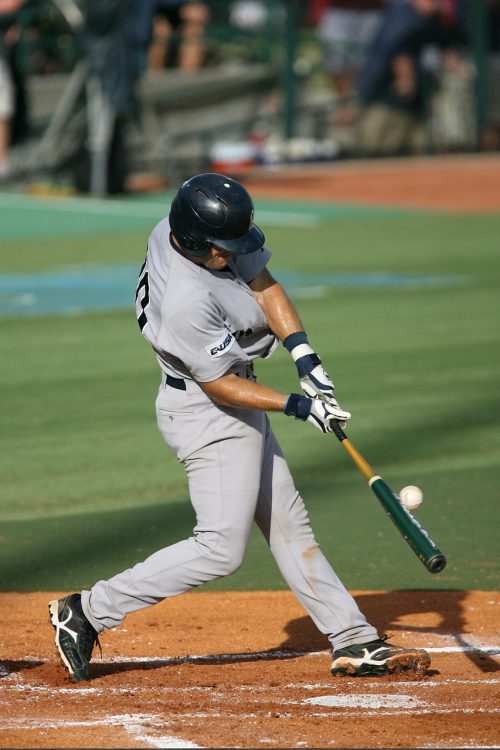
As coaches, we are constantly observing our players: we look at their technique in search of appropriate interventions; we read their body language to understand their mood;z7 we see when they are tired and in need of a substitution.
We also listen when they say they are tired (and either encourage one more rep, or give them a break), and try to cheer them up when they sound sad.
But how many of you listen to their performance? Most sport skills are noisy. The characteristics of those acoustic signals differs with the quality of performance. Last week, I had a wonderful conversation with the world-renowned baseball coach Lionel Chattelle. Among other things, we talked about auditory observation. He describes bat-ball contact as a “Thud” when batters are tense and over-grip. It results in a weak hit with the bat almost pushing the ball. Contrast this with a sharp “Crack” when the wrists are loose and the swing is more like a whip —which coincidentally also cracks 1 —and sends the ball flying faster and farther.
There are other sounds along this spectrum, which coach Chattelle can use as an evaluation and feedback tool when working with baseball players. Similarly, skilled outfielders use these sounds to recognize (and subsequently react) to where the ball is going 2.
It is impossible to simultaneously focus ones gaze on two locations, so umpires look at the base being stepped on while listening for the ball slapping the glove 3.
Sprinting is another example. Again, thuds —or stomping— are bad. Instead, the steps should be almost silent. This does not mean gentle, ninja-like steps. It means applying maximum force to the ground with a correctly placed and positioned foot, in as little time possible (aka impulse). There will be some sound, but any noise produced is mechanical energy being converted into acoustic energy. More noise means more propulsive energy is being wasted on things other than propelling the centre of mass forward. Over-strides sound different from under-strides, and neither sound like a perfect foot strike. A scratching sound or that of tearing of turf is indicative of excessive limbo-pelvic rotation. Stride frequency and ground-contact time are also more easily detected with the ears than with the eyes.
Aural observation is an important and overlooked 4 skill in a coaches (and players) toolkit. Training the ears and brain to detect the way acoustics vary with execution of sport skills helps with the coaching and learning processes. This facilitates the acquisition of technical and athletic speed. It improves cognitive speed though faster recognition and reaction 2.
Landing, breaking, redirecting and changes of direction 5 each produce a myriad of sounds depending on the efficiency of the employed technique. The variety of tones is compounded when surface and footwear combinations.
The strings in the sweet spot of a badminton or tennis racquet sounds markedly different from anywhere else. The whoosh of the racquet head slashing through the air changes pitch as it rotates about its long axis.
The rattle of plates (yes, even bumper plates with collars still make a sound) on a barbell varies with the rhythm of the lift and how well the the joints (and flex of the bar) are co-ordinated.
The sound of a breath cycle when in sync with the jump, wind-up, and swing of a volleyball spike is noticeably different from when air is being held by the glottis or is otherwise out of phase with the mechanics. Consequently the speed and accuracy of the hit can be often be predicted before contact even takes place. The acoustic signature of that contact gives the final nugget of information.
Even without a cheering crowd, sports create a soundscape: An opponent hits the ball, a player steps towards it, plants, winds-up, swings, and hits it back… the sequence of tones and rhythms create a sort of song that conveys as much information to the ears as the reflection of light conveys to the eyes. As coaches and players, we need to learn to listen as much as we look. Sound augments sight. It helps us better understand what is going on. Playing music during practice drowns out a lot of those sounds, much like replacing the gym lighting with multicoloured flashing lights would make it really hard to see. It is one of the reasons I ban music in my technical practices and lifting sessions.
There are other reasons to eschew music when training, which would likely make a good topic for a future insight. Stay tuned6 .
—CG
- But for different reasons http://hypography.com/news/physical-sciences/32479.html
- https://www.scientificamerican.com/article/baseball-bat-cracks-and-c/
- https://dt5602vnjxv0c.cloudfront.net/portals/54645/docs/umpire/mua_umpire_manual.pdf
- no pun intended, but it is apt.
- As explained in a previous Insight, Redirection and Change of Direction are two separate classes of skill with drastically different neuromuscular and biomechancial demands.
- that one was intended 😉
